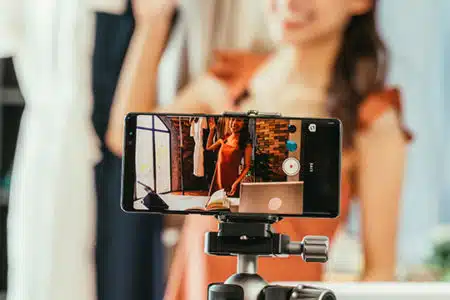Table of Contents
Top 10 Healthcare Social Media Tips to Grow Your Business

Companies from every industry have made the leap into social media, with most major brands being present across all platforms. Giving up the chance to carry out social marketing strategies is a waste of opportunities and a risk of losing customers to rival businesses. That’s why healthcare social media has become a necessity for hospitals and clinics.
To help you develop a healthcare social media marketing strategy or improve your already existing efforts, I came up with this handy guide. These 10 tips are here to teach you how to take advantage of these social platforms in a way that helps you grow your business online. And I added some great examples on top of it, so you can get some inspiration from them, too.
Let’s jump in!
Table of Contents
1. Stand Out by Giving Your Organization a Voice and Image
Healthcare social media can come off as a bit of a dull environment, addressing cold, hard facts about medicine and the human body. Seriousness is great if you’re explaining the technicalities of a new treatment—- but not so much for growing your social media presence online.
Luckily, you can liven up your organization’s image by giving it a unique voice. The first step in using social media as a marketing tool should be to consider how you present yourself online, and how you want to sound to your followers, thus building a brand identity.
You can choose a specific tone that shows a bit of personality, and add elements that appeal to your target audience, like using emojis if you’re talking to a younger audience, for example. It’s important to keep professionalism in mind and find a style that suits your practice best. This will help you stand out among other healthcare accounts, and build stronger connections with your followers.
Sharing mental health stories leads to connectedness, empowerment, appreciation, hope, & validation. 💥 Simply not feeling alone can help someone else gain a more positive attitude toward their challenges, shattering the silence of stigma. 💪 Learn more ➡️ https://t.co/rkKcxUIyqk pic.twitter.com/s69LbLg2Z2
— NoStigmas Mental Health (@NoStigmas) January 30, 2023
2. Build Favorability by Fighting Misinformation
A big consequence of this age of connectivity is misinformation. Healthcare has long been a subject of widespread myths and false beliefs, but with the Internet’s ability to exponentially distribute information, it has become a serious problem that can be very harmful to both patients and medical professionals.
A way to combat inaccurate healthcare claims is by raising awareness and providing the public with links to credible sources. You can create awareness campaigns for patients and healthcare professionals or make posts busting common-belief myths. Showing you care about this will help you gain your audience’s favor and establish yourself as a trustworthy actor.
3. Encourage Visits to Your Facilities by Bringing Attention to Specific Health Issues
An important aspect of healthcare social media is using your platform to bring awareness to diseases and health issues. The World Health Organization has set a series of global public health days in an effort to educate people, spread understanding, and mobilize support for action. When developing your content strategy, they’re a great asset to keep in mind.
These important dates are great opportunities to interact with your audience and expand your presence online, show your commitment to the cause and your sympathy with the afflicted group.
By bringing attention to these specific issues, you’ll be offering your support, while reminding your followers that it could be time for a checkup. So you won’t only bond with a specific sector, you’ll also be encouraging visits to your facilities. That’s a solid strategy in my book!
Today in @AneurinBevanUHB its breast cancer awareness day and in true @GAUABUHB fashion we again have turned pink to remember those who have fought or are fighting cancer. 🎀💕 #Pink #Scrubs #Breastcancerawareness #Support pic.twitter.com/CoIfC5E2x0
— Mark Gordon BSc(Hons) OStJ (@welsh_lad89) October 21, 2022
4. Connect With Your Audience by Showing the Behind-The-Scenes
Most people—me included—don’t really know what happens inside the exam room. If you aren’t an expert, medical procedures and technology can feel like a bit of a mystery, and this often leads to doubt and reluctance when it’s time to book a consult.
Sharing what happens behind the scenes can make potential patients more comfortable with your practice. You can familiarize your audience with your staff and practitioners by introducing them, or even guide them through your installations with a compelling video.
By doing this, you’ll be revealing a new, human side of your brand, making it easier for your audience to connect with your organization and the professionals working on it. On the other hand, it can be a decisive aspect in attracting other businesses or medical professionals who’re thinking of working with you.
View this post on Instagram
5. Educate Your Followers by Taking Advantage of Video Content
As a health institution, you’ll frequently need to explain complicated information to your audience, such as the steps of a new treatment or the significance of the new service you’re providing. Videos are particularly effective for conveying information to an audience because they combine both visual and audio elements to transform a message into an attractive narrative.
For example, explainer videos are perfect for illustrating complex ideas in a simple and engaging way. The use of smooth motion graphic transitions helps attract and keep a viewer’s attention, while animated characters make it easier for the audience to connect with what you’re saying.
These types of videos can be a way to help your audience easily understand intricate healthcare topics, improving the quality of care you offer.
6. Increase Engagement by Offering Q&A Sessions
Followers’ interactions, or lack thereof, can be a deciding factor on whether your content becomes a success and reaches several accounts or dies down after a few feeble likes. You can offer your healthcare social media as a platform to answer health-related questions to encourage your audience to engage.
A smaller, more involved following has a higher value than a larger, uninterested one. Invite users to ask you questions, either in comments or through direct messages, and then make posts or a live video session to respond to them. If they aren’t asking much, you can quiz them yourself with polls to gauge their knowledge on certain topics.
With Q&A sessions, your followers will get the chance to ask what they want to know. Showing yourself open to conversation and willing to listen is the first step in building a strong, engaged community. And once your audience knows you’ll be paying attention to what they have to say, they’ll feel free to interact with anything you post.
7. Build Trust by Sharing Feedback and User Generated-Content
Customer feedback plays a very important role in showing your credibility. After all, people find what other users have to say much more authentic and reliable than anything shared by the company itself. That’s why many brands have been sharing user-generated content on their profiles lately.
UGC stands for any piece that has been created and posted online by a company’s customers. What makes this type of content effective is that it’s told from their perspective, which allows viewers to relate to the message more easily.
Positive comments and recommendations are immensely beneficial for improving your company’s image, building trust, and giving reassurance to those who are considering your services. And in order to generate leads, all of this is crucial. To start with, you can encourage UGC by asking questions or sharing content created by your followers.
“One of the other reasons I believe that my diagnosis took so long, even for someone who had been seen by countless therapists and psychiatrists, was that I was not alone in my misconceptions about ADHD.”https://t.co/Uq30ngvOZW
— NAMI (@NAMICommunicate) April 4, 2023
8. Demonstrate Your Knowledge by Discussing the Latest Innovations
There are new discoveries regarding treatments being made every day. But this information is a bit inaccessible to the common public, who may not be up-to-date with the medical sector’s advancements.
As a professional, you are in a unique position to share breakthroughs, provide knowledge, and clear doubts. You can discuss the latest innovations on your healthcare social media, sharing the achievements in layman’s terms with an expert’s perspective that most news outlets often lack.
Even if you aren’t the one making these discoveries, becoming a spokesman will establish you as a knowledgeable actor in the healthcare sector. You can gain a privileged position as the go-to account for people who are looking to learn more on these topics, helping you build brand authority among the public and your peers.
Catch up on the latest #NIH’s research news: A potential new target for #HIV cure efforts, a new #autoinflammatory disease, a drug showing promise for blinding childhood disease, and updates on the latest #opioid use disorder (#OUD) research. pic.twitter.com/WFldWxuZqQ
— NIH (@NIH) April 3, 2023
9. Reach New Audiences by Using #Hashtags
Social media users often use hashtags to find related content or see what others are saying about a certain matter. You can take advantage of this trend to increase your visibility and widen your healthcare social media’s reach. How? Simply by using hashtags you know people in the medical industry are searching for.
After reaching your intended audience, you need to entice users to visit your profile. So, try to add useful and interesting data to the tags you use, like professional advice on a certain health issue, or curious facts. The goal is to stand out among the thousands of posts that probably surround a given topic.
Make sure to stick to a handful of hashtags, though, as overuse can make it feel like spam for users, and some platforms will even ban you for it—cough, cough, Instagram.
It’s #StressAwarenessMonth! If you’re feeling stressed, try engaging all your senses:
👁 Name 5 things you see
✋ Name 4 things you can touch
👂 Name 3 things you hear
👃 Name 2 things you smell
👄 Name 1 thing you taste— American Foundation for Suicide Prevention (@afspnational) April 1, 2023
10. Boost Your Bookings by Leveraging Advertising
Algorithms are complex and they’re constantly evolving, which is why, sometimes, even the people who follow you don’t get to see what you post. That’s why building a solid advertising strategy can be the key to expanding your reach to new and existing audiences, and giving a boost to your healthcare social media marketing efforts.
With sponsored content, you can ensure that people who may not follow you get to see your posts, making online advertising a sustainable strategy to reach new audiences (as long as you can afford it, of course). Most platforms offer various options for promoted posts, so you can create an ad and choose the budget that fits you and your needs, without spending more than you want to.
In order to create professional level healthcare ads, make sure they are pertinent, well-written, and include an appealing image to attract your target’s attention and engage them. You’ll also want to learn each platform’s specific terms of service regarding health content.
Wrapping Up
Both the general public and medical institutions have a lot to gain from healthcare social media. As you offer a platform that helps inform the public and fight misinformation, you’re also opening the gate to improving your patients’ care by listening to them, reaching new audiences, and increasing your bookings.
I know social media marketing can be challenging, but the opportunities that these platforms offer in healthcare are endless. Try out each of the tips I’ve mentioned here to create a solid, comprehensive online strategy and see how it helps you start meeting your business’s marketing objectives.


